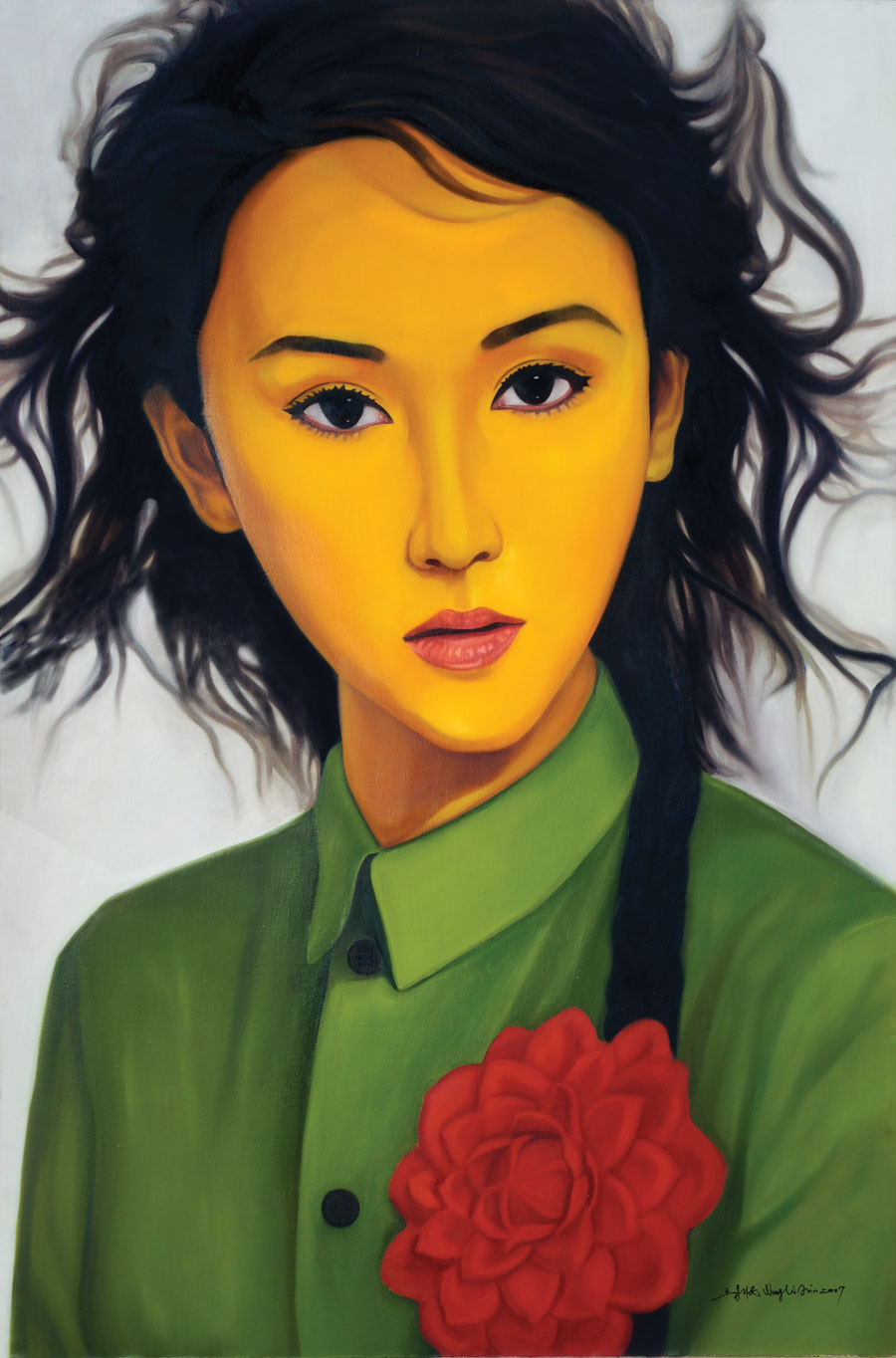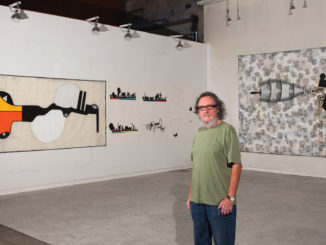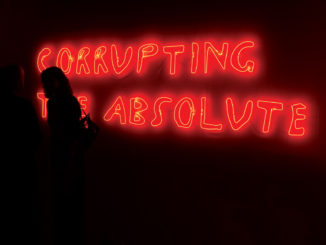
Anyone who has visited China recently can only describe what they see in superlatives — the tallest skyscrapers, the fastest trains, the biggest cities, the worst pollution. The emerging country’s growth spurt might be unprecedented in history, considering its size and population. Shanghai in particular elicits the most amazement, a spanking new, glittering city that has sprung skyward to become an economic and cultural super power almost over night.
Like Shanghai, the artistic output from China is in hyperactive mode, as anyone even slightly acquainted with the art world will know.
Not only are works from emerging artists lava-hot on the auction block, but the creative spirit bursting from the emerging nation is also volcanic. A new generation of Chinese, no longer tethered to the old dogmas of the last century, is feeling free to experiment and question new roles in a new society. This includes not just questions about political systems, but also of gender, urbanization, art, and culture. It’s pretty exciting – and edgy – times for the Middle Kingdom.
To sample some of that energy, it’s worth a trek to ArtSpace/Virginia Miller Galleries, the 35-year-old institution in Coral Gables, for its second-in-a-row contemporary Chinese art show. (The first, which ran through February, was a funky collection called “Six 21st Century Chinese Neo-Pop Artists.”) This one highlights nine emerging artists, eight of whom have never been seen in the United States. In fact, artists just out of the hot-house art schools (and sometimes still in them) in Beijing and Shanghai are being picked up almost sight unseen sometimes, bought by Chinese and Western collectors alike. Whether or not it is a pre-mature success, only time will tell.
Back over here at Virginia Miller, the selection is all painting, save for one sculptural artist, and all figurative. And while there are some common threads that could link them to being labeled Chinese, the paintings are also varied in style and theme. In other words, an interesting sample from that prolific nation.
For example, take two of the strongest pieces in the show: “I Love Tiananmen Square,” and “Times Tag #16.”
The former is the first image of the show, it’s title and coloring instantly – and intentionally – recognizable as “Chinese.” It’s a beautiful and satirical work, with clones in Mao suits standing at attention, on a bright blue carpet, in front of a deep red curtain. The curtain is parted, revealing the gate of Tiananmen Square in front of the Forbidden City with the famous iconic painting of Mao hung on it, with the sun breaking through clouds and jet fighters zooming across the sky above it. You can almost hear the cheesy music that would accompany such a scene if it were a movie. The drawings are simple and the colors bold, mimicking not only the drone-nature of the apparatchik, but also the style of Socialist Realism. He didn’t name it simply “Tiananmen Square,” but adds “love” to it.
Tiananmen is the political and cultural heart of Communist China, and also, as Westerners may better remember, the site of the 1989 freedom demonstrations and the subsequent successful crushing of them. Ironically, while the government succeeded in clamping down on overt political dissent, the commercialization of its culture and especially art, has only exploded.
The painter, Zhu Yan, often incorporates a stage-like frame to his pieces, like in this one. As he says, “a stage refers to the drama of our own life’s differences and changes.”
An image of another China, and another conundrum for the emerging nation, is reflected in “Times Tag.” This more abstract, huge triptych is brushed with dirty, muted colors. No “happy” red tones here, no government suits – just life on the polluted, congested streets of the new China. The working class people are on motorcycles, cramped next to each other, literally engulfed by the exhaust of their vehicles and their lives. It’s a gritty urban reality from Liao Zhenwu, who paints in swirling grays, whites and blacks, such as in “Times Tag #26,” where a singular motorcyclist emerges from the fog, Mad-Max like. His works fill up one room of the gallery.
Another remarkable image confronts the viewer when entering the space, “The Bicycle Thieves,” by Liang Haopeng. This one deserves long contemplation. Here, the motorized form of transport is replaced with the simple bicycle, but the painting feels similarly ultra-urban and disturbing. Five thuggish looking men, some shirtless, one with fists clenched, are pictured caught in the act of stripping a bike. Their crazed faces look directly out at us, their skin eerily sallow, a strange light illuminating them in mid-action.
What’s particularly dramatic is the perspective of the viewer. While the suspects are reacting, presumably, to cops or other authorities with their menacing gestures and open mouths, we are the ones they are looking at directly from the canvas. Really, are they accusing you of something?
Like “Tiananmen,” Liu Qi Ming’s political message is hard to miss in her series of three oil paintings called “My 1989.” These somber works depict a topless women hanging mid-air above the sea. Both the water and the sky are a murky gray-blue, making the bright orange of her bathing-suit bottom, and especially, of the rope from which she hangs, particularly startling. She is faceless, and hovering between two worlds. If there was any question about the message, Liu says this: “The politics of our society keep us dangling above a mysterious future, leaving us all at the mercy of the hands that hold our strings.”
For people used to fairly a-political art in the Pop and post-modern world, such a statement might make them classify the work as having necessarily been formed within a totalitarian system, as a reaction to it. But obviously, the feeling that more powerful hands pull our strings is a universal one.
Other images of women in the show are political but also influenced by Pop and Japanese culture, maybe a reflection of the post-Tiananmen commercialization of China. Li Jia’s girl/woman also dangles in mid-air, also in front of a blue background, but the two images in this series are much lighter. In Japanese anime tradition, she looks very sweet and cute, her oversized head balanced on her tiny, dainty body, and the blue sky behind is cartoonishly benign. And she hangs from a rose. The rose, however, is not bursting into bloom but fading fast, its petals already dropping. But it still controls the strings, from which the woman hangs.
The three large, female portraits hanging in the back seem to combine elements of Pop and Socialist Realism, along with some tell-tale signs of anime. While the hair-cuts on the highly stylized women suggest someone who might be leaving a hip Shanghai gallery circa 2008, all three are clothed in the old-fashion Communist uniform ubiquitous in the Cultural Revolution. In addition, the culturally significant red chrysanthemum is pinned to two of the women’s’ chests. But these bright flowers don’t look like lovely accessories, rather like heavy badges trapping them in a singular ideology.
In contrast, maybe the least political and gentle of the works in “Under the Radar,” are the two from He Zubin. Again, the heads are somewhat over-sized in these figurative works. But these seem to reference pre-Cultural Revolution times and style – they are quiet domestic scenes, dreamily executed. In “Guess + Surmise,” an older boy teaches a younger one a hand game, both have very exaggerated Chinese features, and are painted in mute, soft tones. In “Catnap + Dogsleep,” two boys rest their heads gently next to each other, their elongated fingers reaching out and towards each other. Their skin is bright yellow, and their hair, shirts and backdrop various shades of gray – but not a murky, sickly gray, a much more electric and beautiful one.
The works of Liao Yibai literally stick out, as they are made from stainless steal and don’t hang from walls. These sculptures of huge, round-headed Buddhas – or meditating angels — sitting on miniscule bodies and feet can look at first like space men. One crawls, one sits in the meditating position, with various spike-like objects ejecting from the ground around his feet and from his head. In fact, the spikes represent the splash from rain drops falling on him, a reference to the springtime Buddhist water festival of rebirth. As befits the meditative concept, the sculptures are calming and reflective – literally so, as your reflection and that of parts of the gallery can be seen in the shiny stainless steel heads.
There is no doubt a Chinese thread is woven throughout these works, whether it is stylistically or thematically, but the works in “Under the Radar” are also clearly part of a global village. A village that, when you can see Chinese artists who’ve never been seen on these shores before at a gallery in Coral Gables, we are certainly a part of.



Be the first to comment